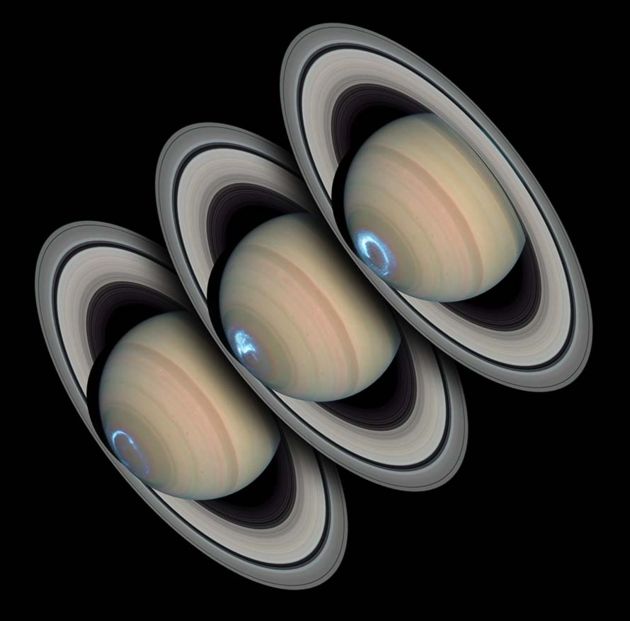Bright Lights, Eerie 'Heartbeat' at Saturn

When a large storm of charged particles leapt from the Sun in January 2004, scientists jumped at the chance to observe what would happen when the tempest reached Saturn. The storm kicked up bright lights above the planet and created radio emissions that sound like an eerie, hissing heartbeat.
The effects were not unexpected. Solar storms charge the upper atmosphere of Earth in a similar manner, creating auroral displays in the polar regions sometimes called the Northern Lights or Southern Lights. Jupiter has aurora too.
Researchers expected Saturn's aurora to have characteristics in between the lights of Earth and Jupiter. Instead, they found some surprises.
The auroras were imaged in ultraviolet light over several weeks by the Hubble Space Telescope. The Cassini spacecraft, still en route to the planet at the time, recorded radio emissions, which fluctuated in lockstep with the intensity of the aurora.
"We had expected that this might be the case, based on our understanding of auroral radio signals from Earth's auroras, but this is the first time we've been able to compare Saturn's radio emissions with detailed images of the aurora," said William Kurth of the University of Iowa. "This is important to our on-going Cassini studies because this association allows us to have some idea of what the aurora are doing throughout the mission from our continuous radio observations."
Audio files of Saturn's sounds, including the heartbeat of its rotation, are available here.
Auroral displays are the result of charged solar particles interacting with a planet's magnetic field. Electrons are accelerated to high speeds, and race toward the planet along magnetic field lines, which converge at the poles. The electrons stimulate air atoms and molecules, making them glow.
Get the Space.com Newsletter
Breaking space news, the latest updates on rocket launches, skywatching events and more!
Among the differences in Saturn's auroral displays:
- While a terrestrial aurora typically lasts for a few minutes, the Saturnian variety go on for days.
- Some auroras at Saturn remain fixed as the planet rotates beneath them, as at Earth. But sometimes they move with the rotation of Saturn, mimicking what happens at Jupiter.
- When an aurora at Saturn brightens, its diameter around the polar region shrinks. At Earth, it expands.
The unexpected behaviors suggests Saturn's auroras are driven in some unknown manner by both the solar wind of charged particles and the Sun's influential magnetic field, which because of the greater distance would interact differently with Saturn, scientists said. But more research is needed to learn what creates the unique features in Saturn's Southern Lights.
The results are detailed in three papers in the Feb. 17 issue of the journal Nature.
Join our Space Forums to keep talking space on the latest missions, night sky and more! And if you have a news tip, correction or comment, let us know at: community@space.com.

Rob has been producing internet content since the mid-1990s. He was a writer, editor and Director of Site Operations at Space.com starting in 1999. He served as Managing Editor of LiveScience since its launch in 2004. He then oversaw news operations for the Space.com's then-parent company TechMediaNetwork's growing suite of technology, science and business news sites. Prior to joining the company, Rob was an editor at The Star-Ledger in New Jersey. He has a journalism degree from Humboldt State University in California, is an author and also writes for Medium.











